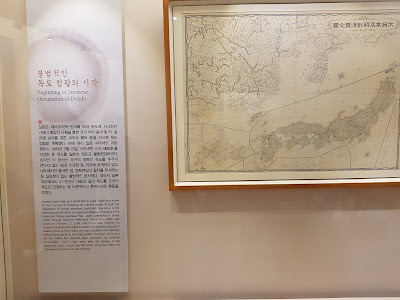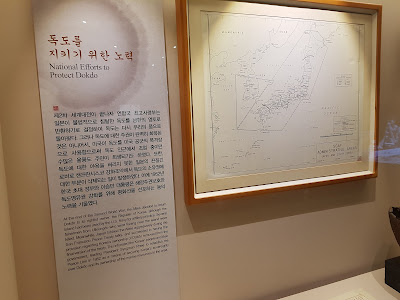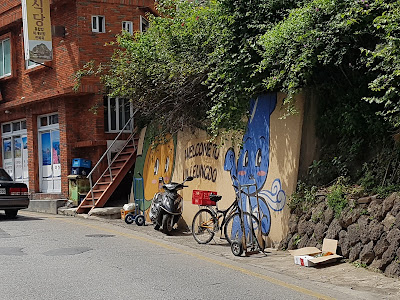On 7/24~ 7/27 , I went on a trip to Ulleungdo and Dokdo island ! I want to share with you what I saw and felt there. Before you get started, I suggest you read my Dokdo postings before you read this.
Let me tell you about VANK first. VANK is non-governmental organization and cyber diplomatic body founded in Republic of Korea since 1999. There are 130,000 elementary, middle and high school students in VANK. VANK spreads Korean culture to the world and makes a lot of effort to correct all the errors about Korea in the global society. Members of VANK share meaningful friendship via the internet with the people from other countries and learn about their history and culture by cultural exchange. Furthermore, to become a global citizen, they learn about global issues, such as Climate Change, International conflicts, Poverty and Disease.
I'm a member of VANK ! Few months ago, VANK recruited Dokdo promotional ambassadors. It's a Dokdo promotion project and it is promoted regularly. This was the 10th project. A lot of people applied for it, including myself. I got accepted ! 214 people got selected and we engaged in lots of activities to protect and promote Dokdo and East Sea for about three weeks. 38 people became Dokdo ambassadors and VANK picked top 15 activists. I became one of the top 15 Dokdo ambassadors and got a chance to visit Ulleungdo and Dokdo !!
I along with other Dokdo ambassadors got to visit Dokdo. It was my first time there and I was captivated by the beautiful scenery.
- Ulleungdo
A lot of foreigners visit Ulleungdo and it's very famous for its beautiful landscape. More than 10000 people reside here. Ulleungdo is full of korean tradition and it's so peaceful.
As soon as you enter into Ulleungdo, you'll be able to see Do dong harbor.

Near Do dong harbor, there are lots of stores that sell Ulleungdo's local products and souvenirs.
- Beautiful view of Ulleungdo
I took this picture on the cable car to the Dokdo observation platform. As I've mentioned in my prior postings, you can see Dokdo from Ulleungdo when the weather is nice. Unfortunately, on this day, it was cloudy.
- Dokdo museum
There's a museum displayed with lots of historical documents about Dokdo and East Sea. In this museum, you'll learn about the history of Dokdo and East sea. I took lots of pictures.
< Incorporation of Dokdo into Korean territory >
- Some 1,500 years ago, there was a Korean maritime kingdom called Usanguk, situated on the present-day islands of Ulleungdo and Dokdo. This kingdom often mobilized its naval forces to strike the southeastern coast of the Korean Peninsula, causing Silla ( 57-935 BCE ) , which was based in the area, to strike back, conquer the kingdom, and incorporate its islands into its territory. Despite that, however, Usanguk survived throughout the following Goryeo period ( 918-1392 BCE ) by maintaining a lord-vassal relationship with Goryeo, until it lost its statehood and was forced to concede all of its land to the superior Goryeo forces.
< The Beginning of Dokdo's History >
The oldest surviving historical record of Ulleungdo and its subordinate islets, now called Dokdo, reveals that these islands were the territory of a tribal kingdom called Usanguk, which was incorporated into Silla in 512 ( 13th year of King Jijeung's reign ) following its subjugation by Silla's General Isabu. After its subjugation, however, Usanguk survived as a semi-independent state under a lord-vassal relationship with Goryeo ( 912-1392 BCE ), the dynasty that seized power from Silla. The rulers of Goryeo had sought to control the insular chiefdom through exchanges and support, but the turmoil caused by the Mongolian invasion of Goryeo in the 13th century led to the plundering of Usanguk by the Jurchen and Japanese pirates, leading to its eventual fail. However, the Goryeo rulers and their people continued to protect Ulleungdo and Dokdo against foreign enemies, even while struggling to cope with the Mongolian invasion.
< Dai Nihonshi ( History of Great Japan ) >
This is a Japanese history book published in the Edo period (1603-1867 ) that contains records of a person from Ulleungdo, Goryeo, drifting into Inaba ( currently the Tottori Prefecture area ) from sea.
< Dokdo and the Repatriation Policy of Joseon >
With the rapid increase in raids launched by Japanese pirates upon the islands and coastal areas of the Korean Peninsula in the 14th century, the early rulers of Joseon (1392-1910) took steps to protect their people living in remote areas from such foreign intruders. One major policy they implemented to address the issue called for the relocation of people in vulnerable areas, particularly faraway islands, to safe areas on the mainland. In addition, they sent government officials to patrol the waters around such remote islands and coastal areas in order to secure the dynasty's sovereignty over them. This policy caused both Ulleungdo and Dokdo to become uninhabited, although boats from fishing communities along the southeastern coast of the Peninsula continue to frequent the islands for fishing.
< Sejongsillok jiriji ( Geography Section of the Annals of King Sejong's Reign) >
This is a representative, official geographical text of the early Joseon Dynasty, containing geographic information on both Ulleungdo and Dokdo. In particular, the record indicating the location of Dokdo shows that Joseon had a clear awareness of Dokdo at that time.
< Japan's Awareness of Dokdo >
Following the Ulleungdo Border Dispute, the rulers of Japan officially acknowledged that Ulleungdo and Dokdo were the territory of Joseon and established a law banning their people from entering the region. The Japanese government announced that anyone found to be in violation of the law would be sentenced to death, and it posted warning signs dissading people from crossing the sea to either of the two Korean islands. These measures, however, failed to prevent some Japanese fishermen from continuing to sail to the islands to exploit the region's marine resources.
< Illegal Annexation of Dokdo by Japan >
In the late 19th century, the Joseon Dynasty implemented a plan for the redevelopment of Ulleungdo. The plan involved the reform of administrative divisions to make both Ulleungdo and Dokdo part of Uldo-gun, bringing them under the jurisdiction of Gangwon-do, as well as the implementation of measures for the effective management of the islands and consolidation of Korea's sovereignty over them. Japan, however, openly displayed its imperial ambitions by asserting that Dokdo was terra nullius, or "unowned land", and illegally incorporating it into its territory. With this, Dokdo became the first part of the Korean territory to be annexed by Imperial Japan.
< Redevelopment of Ulleungdo and Administrative Division Reform >
As Japanese fishermen continued to frequent Ulleungdo, even after the implementation of the policies on territorial protection, the Joseon Dynasty decided to implement a special redevelopment plan for the island, though which it encouraged Korean people to move from the mainland and settle there. Arriving on Ulleungdo in 1883, the first group of new settlers was made up of 54 people and 16 households, and the number of settlers continued to grow. By 1887, there were a total of 1,134 people living in 12 villages across the island. However, this migration of Korean people from the mainland failed to stop the Japanese from exploiting the resources in the seas surrounding the island, leading Emperor Gojong ( formerly King Gojong ) to issue Imperial Decree No.41 on October 25, 1900, whereby the three islands in the East Sea- Ulleungdo, Jukdo, and Dokdo- were incorporated into Uldo-gun, the 27th county under the jurisdiction of Gangwon-do. The decree clearly stated that Dokdo was a crucial part of the Korean territory.

< Beginning of Japanese Occupation of Dokdo >
Imperial Japan drew up a secret plan to seize Dokdo from Korea for the purpose of increasing its national wealth through the exploitation of marine resources, particularly sea lions, in the waters around the island and gaining a strategic advantage in the impending Russo-Japanese War. Japan attempted to annex Dokdo through Shimane Prefectural Notice #40, which was issued on February 22, 1905. The notice was, however, an unlawful document that ailed to achieve its purpose, because it treated Dokdo as terra nullius and was circulated only internally, without being issued to the other parties concerned. As such, it did not follow the required legal procedure for territorial incorporation. This is why, even after the release of the prefectural notice, Dokdo was still widely recognized within the Japanese government as part of Korea.
< Ulleungdo and Dokdo as Seen by Third-party Countries >
Exploration of the East by the Western maritime powers during and after the 18th century resulted in the production of documents and maps containing important geopolitical information on the Korean Peninsula. These historical records show that Western countries regarded both Ulleungdo and Dokdo as part of Korean territory. According to the oldest remaining map of Korea made in the West, drawn up in 1734, Ulleungdo and Dokdo are remarked as Korean territory, although their names are written using the Chinese pronunciation. Other important materials concerning Dokdo made by the Western powers in the 19th century include the logbook of the American whaler Cherokee ( 1848 ) , Carte Generale de I'Ocean Pacifique made in 1851 by the French navy, logbook of the American whaler William Thomson ( 1853 ), a Russian naval map ( 1855 ), and an edition of Britain's Nautical Magazine ( 1856 ).
< National Efforts to Protect Dokdo >
At the end of the Second World War, the Allies decided to return Dokdo to its rightful owner, the Republic of Korea, although the island had been used by the U.S. Navy for artillery practice. Several fishermen from Ulleungdo who were fishing near the island were killed. Meanwhile, Japan lobbied the Allies aggressively during the San Francisco Peace Treaty talks, and succeeded in having the provision regarding Korea's ownership of Dokdo removed from the final version of the treaty. This infuriated the Korean people and their government, leading President Syngman Rhee to establish the Peace Line in 1952 as a means of securing Korea's sovereignty over Dokdo and its ownership of the marine resources in the area.
< Guardians of Dokdo >
Because Korean people live on the island and work around it, as their ancestors have done since ancient times, Dokdo is Korean territory. Today, the island is inhabited by numerous Korean people, who are working and carrying out various duties. Among these residents are Kim Seong-do and his wife, Kim Sin-yeol, to whom Dokdo is the bedrock of their livelihood; members of the Dokdo Coast Guard, who are carrying out their duty to protect the territory of Korea, staff members of Dokdo Lighthouse, whose are responsible for giving beacon signals to aid vessels navigating at sea, and a group of civil servants sent from the administration of Ulleung-gun, who are tasked with ensuring the safety of the tourists visiting the island.
< Residents of Dokdo >
During the late 1940s, a group of ' sea women ' ( Haenyeo ) arrived on the island and set up a temporary shelter, which they used while fishing in the area. These were 'residents' of Dokdo. Later, in 1965, a fisherman named Choe Jong-deok obtained the exclusive rights to the fishing grounds of Dokdo and settled down on the island. When he had his Dokdo address officially designated in 1981, he became the first real resident of Dokdo, and lived there until his death in 1987. In 1991, another fisherman, Kim Seong-do, officially changed his address to Dokdo and, 16 years later, became the administrative head of the community of Dokdo-ri. He still lives on the island today.
< The Dokdo Coast Guard, Securing the Frontlines of the Korean Territory >
Founded in July 1954 as the successor to the Dokdo Volunteer Guards, the Dokdo Coast Guard has been committed to the protection of Dokdo and its surrounding waters. The coast guard lost seven officers in the early stages of the construction of defense facilities on the island, as they faced harsh geographic and environmental conditions, but it has continued to increase its capabilities and improve related facilities, including its radar system. It has been through their commitment and incredible effort and self-sacrifice that Dokdo has remained a peaceful Korean island.
< Dokdo, Home of Culture and the Arts >
Located in one of the most remote places in the East Sea and designated by the Korean government as a Special Protection Area, Dokdo had long been inaccessible to ordinary Korean citizens. However, with its historical significance having recently gained greater recognition among the Korean people, the island has come to serve as a venue for various educational, cultural, and artistic activities related to Korean history. The recent rise in the number of visitors to the island has led to the organization of various festive events on the island, including an event held to celebrate the opening of the island to all Koreans.
As you can see, There are a lot of stories and documents exhibited about Dokdo. These are all historical facts. These can be complicated but I believe it'll help you understand more about the history of Dokdo.
----
Next day, I went to Dokdo island !!
It takes about two and a half hours to get to Dokdo from Ulleungdo. Because of the unforeseen weather and the high waves, people are only allowed on the island 60-70 days out of the year. If we can't get on to Dokdo, we just go around the island on the ship.
Fortunately, the weather was perfect on that day, so we were able to enter into Dokdo.
Let me tell you little about Dokdo. Dokdo is composed of two large islands ( Dongdo, Seodo ) and 89 small rock islands around it. Dongdo is Eastern island and Seodo is Western island. We can only go to the Eastern Island.
When I got there, my heart was pounding and my emotions were running high. As you know, police officers are assigned to Dokdo to protect the island and there are few Korean residents residing there. Actually, regular visitors can stay in Dokdo for about 30 minutes, but we were able to stay for an hour because we were members of VANK and we had special access to other areas.
The ship going to Dokdo
We were allowed to take this ship ( This particular ship is only for government officers )
Entering Dokdo !!
The color of water was so pretty :-)
' Dokdo Isabu Gil ' sign which means ' Dokdo, Isabu Path'
Western Island
Dokdo Korea
We were allowed to climb up to the top of the mountain. Normally, this area is not opened to the public.
Looking down from the summit, I saw a magnificent view of Dokdo and the East Sea.
Dokdo Harbor
On the summit, there is our national flag called ' Tae Geuk Gi'
' Korean territory' in Chinese character written on the rock !
This is a monument and it said ' Eastern Edge of Korea'
Visitors to Dokdo can receive a Dokdo honorary resident card including people visiting the surrounding areas . ( I got one ! )
I hope you guys visit our beautiful island Dokdo.
On the last day, we did a tour of Ulleungdo.
This is one of our traditional food called ' Bibimbap '
Later, We'll talk more about our traditional food.
Welcome to Ulleungdo !!
Korea welcomes you !
I learned and experienced a lot of things while I was there..
I'm so happy that I got this great opportunity ! Please send me an email if you have further questions regarding these islands.



















































